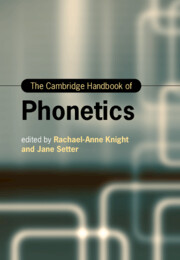Book contents
- The Cambridge Handbook of Phonetics
- Cambridge Handbooks in Language and Linguistics
- The Cambridge Handbook of Phonetics
- Copyright page
- Contents
- Figures
- Tables
- Contributors
- Introduction
- Section I Segmental Production
- Section II Prosodic Production
- Section III Measuring Speech
- Section IV Audition and Perception
- Section V Applications of Phonetics
- 20 Pedagogical Approaches
- 21 Pronunciation Teaching
- 22 Sociophonetics
- 23 Developmental Phonetics of Speech Production
- 24 Clinical Phonetics
- 25 Forensic Phonetics
- 26 The Phonetics of Talk in Interaction
- 27 The Phonetics/Phonology Interface
- Index
- References
20 - Pedagogical Approaches
from Section V - Applications of Phonetics
Published online by Cambridge University Press: 11 November 2021
- The Cambridge Handbook of Phonetics
- Cambridge Handbooks in Language and Linguistics
- The Cambridge Handbook of Phonetics
- Copyright page
- Contents
- Figures
- Tables
- Contributors
- Introduction
- Section I Segmental Production
- Section II Prosodic Production
- Section III Measuring Speech
- Section IV Audition and Perception
- Section V Applications of Phonetics
- 20 Pedagogical Approaches
- 21 Pronunciation Teaching
- 22 Sociophonetics
- 23 Developmental Phonetics of Speech Production
- 24 Clinical Phonetics
- 25 Forensic Phonetics
- 26 The Phonetics of Talk in Interaction
- 27 The Phonetics/Phonology Interface
- Index
- References
Summary
Phonetics is studied by students on a variety of courses, where it may be either elective or obligatory, and its inclusion in the syllabus can be implicit or explicit. In all cases, however, the teaching of phonetics must take into account the needs of students in relation to the rest of their programme, and the use they will make of phonetics in their further studies or work.Here we focus on the explicit teaching of phonetics, as experienced by students of, for example, linguistics and speech and language therapy. We consider key issues in teaching and learning across all aspects of phonetics, including theory, ear-training and production, transcription of segments and prosodic features, and acoustics. The chapter is underpinned by both phonetics research, where it exists, and that from broader educational research and theoretical perspectives. Finally, we consider future directions for the teaching of phonetics, mapping this against the United Kingdom Professional Standards Framework for Teaching and Learning in Higher Education.
- Type
- Chapter
- Information
- The Cambridge Handbook of Phonetics , pp. 503 - 526Publisher: Cambridge University PressPrint publication year: 2021



